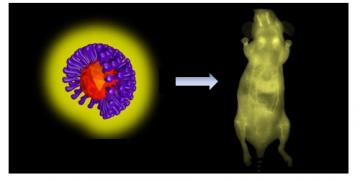The use of organic fluorophores [2] as imaging agents represents an alternative
to radioactive isotopes. However, these fluorophores bleach quickly in light
(sometimes within seconds), becoming imperceptible. Quantum dots
(QD), crystals on the nanometer scale, could become the next generation in
imaging agents: they have remarkable fluorescence properties and
remain operational for one to several hours. They are comprised of a
mixed metal core (e.g. indium, copper, etc.), surrounded by one or more
layers of biocompatible surfaces that allow an in vivo
administration. However, this covering is often lost in practice. As
a result, QD become poorly soluble and thus less mobile; this promotes their
aggregation, reducing their effectiveness and increasing the risk of toxicity.

Left,
a schematic representation of a quantum dot. Right, the biodistribution
of quantum dots in the circulatory system of a mouse
Researchers from the CEA-iBiTec-S developed another biocompatible
covering that is particularly effective. This new single-layer system is
securely anchored to the surface of the metal core. In addition, chains
of polyethylene glycol molecules make these nanocrystals “stealthy”,
i.e.invisible to the body's defenses. This last feature allows
them to navigate through the blood without being destroyed by the immune system.
The first whole-body images of a mouse were obtained, allowing visualization of
the entire circulatory system. The researchers verified that the QD do not
preferentially accumulate in organs. Ultimately, they transit through the liver,
suggesting elimination by natural means. In view of these results, researchers
can consider a broader use of this type of coating for the biocompatibilization
of various nanoparticulate systems.
[1] Ecole supérieure de physique et de chimie industrielles de la ville de Paris.
[2] A chemical substance capable of emitting fluorescent light upon excitation.